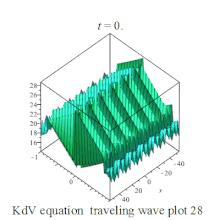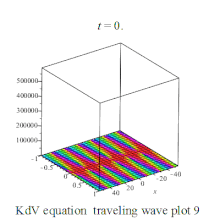科特韋赫-德弗里斯方程 (英語:Korteweg-De Vries equation ),一般簡稱KdV方程 ,是1895年由荷蘭數學家科特韋赫 和德弗里斯 共同發現的一種偏微分方程 。關於實自變量x 和t 的函數 φ所滿足的KdV方程形式如下:
∂
t
ϕ
−
6
ϕ
∂
x
ϕ
+
∂
x
3
ϕ
=
0
{\displaystyle \partial _{t}\phi -6\phi \partial _{x}\phi +\partial _{x}^{3}\phi =0}
KdV方程的解為簇集的孤立子 (又稱孤子 ,孤波 )。
KdV 方程有多種孤波解[ 1] [ 2]
ϕ
(
x
,
t
)
=
1
2
c
s
e
c
h
2
[
c
2
(
x
−
c
t
−
a
)
]
{\displaystyle \phi (x,t)={\frac {1}{2}}\,c\,\mathrm {sech} ^{2}\left[{{\sqrt {c}} \over 2}(x-c\,t-a)\right]}
ϕ
(
x
,
t
)
=
k
t
a
n
h
[
k
(
x
+
2
t
k
2
+
c
)
]
{\displaystyle \phi (x,t)=k\,\mathrm {tanh} [k(x+2tk^{2}+c)]}
ϕ
(
x
,
t
)
=
a
+
b
t
a
n
h
(
1
+
c
x
+
d
t
)
2
{\displaystyle \phi (x,t)=a+b\,\mathrm {tanh} (1+cx+dt)^{2}}
利用Maple tanh 法可得 孤立子解:[ 3]
u
(
x
,
t
)
=
(
1
/
6
)
∗
(
4
∗
C
2
3
−
C
3
)
/
C
2
−
2
∗
C
2
2
∗
c
s
c
(
C
1
+
C
2
∗
x
+
C
3
∗
t
)
2
{\displaystyle {u(x,t)=(1/6)*(4*_{C}2^{3}-_{C}3)/_{C}2-2*_{C}2^{2}*csc(_{C}1+_{C}2*x+_{C}3*t)^{2}}}
u
(
x
,
t
)
=
(
1
/
6
)
∗
(
4
∗
C
2
3
−
C
3
)
/
C
2
−
2
∗
C
2
2
∗
s
e
c
(
C
1
+
C
2
∗
x
+
C
3
∗
t
)
2
{\displaystyle {u(x,t)=(1/6)*(4*_{C}2^{3}-_{C}3)/_{C}2-2*_{C}2^{2}*sec(_{C}1+_{C}2*x+_{C}3*t)^{2}}}
u
(
x
,
t
)
=
−
(
1
/
6
)
∗
(
4
∗
C
2
3
+
C
3
)
/
C
2
−
2
∗
C
2
2
∗
c
s
c
h
(
C
1
+
C
2
∗
x
+
C
3
∗
t
)
2
{\displaystyle u(x,t)=-(1/6)*(4*_{C}2^{3}+_{C}3)/_{C}2-2*_{C}2^{2}*csch(_{C}1+_{C}2*x+_{C}3*t)^{2}}
u
(
x
,
t
)
=
−
(
1
/
6
)
∗
(
4
∗
C
2
3
+
C
3
)
/
C
2
+
2
∗
C
2
2
∗
s
e
c
h
(
C
1
+
C
2
∗
x
+
C
3
∗
t
)
2
{\displaystyle {u(x,t)=-(1/6)*(4*_{C}2^{3}+_{C}3)/_{C}2+2*_{C}2^{2}*sech(_{C}1+_{C}2*x+_{C}3*t)^{2}}}
u
(
x
,
t
)
=
(
1
/
6
)
∗
(
8
∗
C
2
3
−
C
3
)
/
C
2
−
2
∗
C
2
2
∗
c
o
t
h
(
C
1
+
C
2
∗
x
+
C
3
∗
t
)
2
{\displaystyle {u(x,t)=(1/6)*(8*_{C}2^{3}-_{C}3)/_{C}2-2*_{C}2^{2}*coth(_{C}1+_{C}2*x+_{C}3*t)^{2}}}
u
(
x
,
t
)
=
(
1
/
6
)
∗
(
8
∗
C
2
3
−
C
3
)
/
C
2
−
2
∗
C
2
2
∗
t
a
n
h
(
C
1
+
C
2
∗
x
+
C
3
∗
t
)
2
{\displaystyle {u(x,t)=(1/6)*(8*_{C}2^{3}-_{C}3)/_{C}2-2*_{C}2^{2}*tanh(_{C}1+_{C}2*x+_{C}3*t)^{2}}}
u
(
x
,
t
)
=
−
(
1
/
6
)
∗
(
8
∗
C
2
3
+
C
3
)
/
C
2
−
2
∗
C
2
2
∗
c
o
t
(
C
1
+
C
2
∗
x
+
C
3
∗
t
)
2
{\displaystyle {u(x,t)=-(1/6)*(8*_{C}2^{3}+_{C}3)/_{C}2-2*_{C}2^{2}*cot(_{C}1+_{C}2*x+_{C}3*t)^{2}}}
u
(
x
,
t
)
=
−
(
1
/
6
)
∗
(
8
∗
C
2
3
+
C
3
)
/
C
2
−
2
∗
C
2
2
∗
t
a
n
(
C
1
+
C
2
∗
x
+
C
3
∗
t
)
2
{\displaystyle {u(x,t)=-(1/6)*(8*_{C}2^{3}+_{C}3)/_{C}2-2*_{C}2^{2}*tan(_{C}1+_{C}2*x+_{C}3*t)^{2}}}
u
(
x
,
t
)
=
(
1
/
6
)
∗
(
−
8
∗
C
3
3
+
4
∗
C
3
3
∗
C
1
2
−
C
4
)
/
C
3
+
2
∗
C
3
2
∗
J
a
c
o
b
i
D
N
(
C
2
+
C
3
∗
x
+
C
4
∗
t
,
C
1
)
2
{\displaystyle {u(x,t)=(1/6)*(-8*_{C}3^{3}+4*_{C}3^{3}*_{C}1^{2}-_{C}4)/_{C}3+2*_{C}3^{2}*JacobiDN(_{C}2+_{C}3*x+_{C}4*t,_{C}1)^{2}}}
u
(
x
,
t
)
=
(
1
/
6
)
∗
(
−
8
∗
C
3
3
+
4
∗
C
3
3
∗
C
1
2
−
C
4
)
/
C
3
+
(
2
∗
C
3
2
−
2
∗
C
3
2
∗
C
1
2
)
∗
J
a
c
o
b
i
N
D
(
C
2
+
C
3
∗
x
+
C
4
∗
t
,
C
1
)
2
{\displaystyle {u(x,t)=(1/6)*(-8*_{C}3^{3}+4*_{C}3^{3}*_{C}1^{2}-_{C}4)/_{C}3+(2*_{C}3^{2}-2*_{C}3^{2}*_{C}1^{2})*JacobiND(_{C}2+_{C}3*x+_{C}4*t,_{C}1)^{2}}}
u
(
x
,
t
)
=
(
1
/
6
)
∗
(
4
∗
C
3
3
∗
C
1
2
+
4
∗
C
3
3
−
C
4
)
/
C
3
−
2
∗
C
3
2
∗
J
a
c
o
b
i
N
S
(
C
2
+
C
3
∗
x
+
C
4
∗
t
,
C
1
)
2
{\displaystyle {u(x,t)=(1/6)*(4*_{C}3^{3}*_{C}1^{2}+4*_{C}3^{3}-_{C}4)/_{C}3-2*_{C}3^{2}*JacobiNS(_{C}2+_{C}3*x+_{C}4*t,_{C}1)^{2}}}
u
(
x
,
t
)
=
(
1
/
6
)
∗
(
4
∗
C
3
3
∗
C
1
2
+
4
∗
C
3
3
−
C
4
)
/
C
3
−
2
∗
C
3
2
∗
C
1
2
∗
J
a
c
o
b
i
S
N
(
C
2
+
C
3
∗
x
+
C
4
∗
t
,
C
1
)
2
{\displaystyle {u(x,t)=(1/6)*(4*_{C}3^{3}*_{C}1^{2}+4*_{C}3^{3}-_{C}4)/_{C}3-2*_{C}3^{2}*_{C}1^{2}*JacobiSN(_{C}2+_{C}3*x+_{C}4*t,_{C}1)^{2}}}
u
(
x
,
t
)
=
−
(
1
/
6
)
∗
(
8
∗
C
3
3
∗
C
1
2
−
4
∗
C
3
3
+
C
4
)
/
C
3
+
(
−
2
∗
C
3
2
+
2
∗
C
3
2
∗
C
1
2
)
∗
J
a
c
o
b
i
N
C
(
C
2
+
C
3
∗
x
+
C
4
∗
t
,
C
1
)
2
{\displaystyle {u(x,t)=-(1/6)*(8*_{C}3^{3}*_{C}1^{2}-4*_{C}3^{3}+_{C}4)/_{C}3+(-2*_{C}3^{2}+2*_{C}3^{2}*_{C}1^{2})*JacobiNC(_{C}2+_{C}3*x+_{C}4*t,_{C}1)^{2}}}
u
(
x
,
t
)
=
−
(
1
/
6
)
∗
(
8
∗
C
3
3
∗
C
1
2
−
4
∗
C
3
3
+
C
4
)
/
C
3
+
2
∗
C
3
2
∗
C
1
2
∗
J
a
c
o
b
i
C
N
(
C
2
+
C
3
∗
x
+
C
4
∗
t
,
C
1
)
2
{\displaystyle {u(x,t)=-(1/6)*(8*_{C}3^{3}*_{C}1^{2}-4*_{C}3^{3}+_{C}4)/_{C}3+2*_{C}3^{2}*_{C}1^{2}*JacobiCN(_{C}2+_{C}3*x+_{C}4*t,_{C}1)^{2}}}
9.81207
−
7.70406
∗
I
+
5.44331
∗
a
r
c
t
a
n
h
(
10.4881
/
(
−
110.
∗
c
s
c
(
1.40000
+
1.50000
∗
x
+
1.60000
∗
t
)
2
+
110.
)
)
{\displaystyle 9.81207-7.70406*I+5.44331*arctanh(10.4881/{\sqrt {(}}-110.*csc(1.40000+1.50000*x+1.60000*t)^{2}+110.))}
9.81207
−
7.70406
∗
I
−
5.44331
∗
a
r
c
t
a
n
(
10.4881
/
(
−
110.
∗
c
s
c
h
(
1.40000
+
1.50000
∗
x
+
1.60000
∗
t
)
2
−
110.
)
)
{\displaystyle 9.81207-7.70406*I-5.44331*arctan(10.4881/{\sqrt {(}}-110.*csch(1.40000+1.50000*x+1.60000*t)^{2}-110.))}
9.81207
−
7.70406
∗
I
+
5.44331
∗
a
r
c
t
a
n
(
10.4881
/
(
−
110.
∗
c
s
c
h
(
1.40000
+
1.50000
∗
x
+
1.60000
∗
t
)
2
−
110.
)
)
{\displaystyle 9.81207-7.70406*I+5.44331*arctan(10.4881/{\sqrt {(}}-110.*csch(1.40000+1.50000*x+1.60000*t)^{2}-110.))}
KdV方程行波圖 KdV方程行波圖 KdV方程行波圖 KdV方程行波圖
KdV方程行波圖 KdV方程行波圖 KdV方程行波圖 KdV方程行波圖
KdV方程行波圖 KdV方程行波圖 KdV方程行波圖 KdV方程行波圖
KdV方程行波圖 KdV方程行波圖 KdV方程行波圖 KdV方程行波圖
KdV方程行波圖 KdV方程行波圖 KdV方程行波圖 KdV方程行波圖
KdV方程在物理學的許多領域都有應用,例如等離子體磁流波、離子聲波、非諧振晶格振動、低溫非線性晶格聲子波包的熱激發、液體氣體混合物的壓力表等。
KdV方程也可以用逆散射 技術求解。
Korteweg, D. J. and de Vries, F. "On the Change of Form of Long Waves Advancing in a Rectangular Canal, and on a New Type of Long Stationary Waves." Philosophical Magazine, 39 , 422--443, 1895.
P. G. Drazin. Solitons . Cambridge University Press, 1983.
^ 閻振亞著 《複雜非線性波動構造性理論及其應用》 29頁 科學出版社 2007
^ Graham W.Griffiths William E.Schiesser Traveling Wave Analysis of Partial Differential Equations p422-430
^ Graham W.Griffiths William E.Schiesser Traveling Wave Analysis of Partial Differential Equations p391-404
*谷超豪 《孤立子 理論中的達布變換 及其幾何應用》 上海科學技術出版社
*閻振亞著 《複雜非線性波的構造性理論及其應用》 科學出版社 2007年
李志斌編著 《非線性數學物理方程的行波解》 科學出版社
王東明著 《消去法及其應用》 科學出版社 2002
*何青 王麗芬編著 《Maple 教程》 科學出版社 2010 ISBN 9787030177445
Graham W. Griffiths William E.Shiesser Traveling Wave Analysis of Partial Differential p135 Equations Academy Press
Richard H. Enns George C. McCGuire, Nonlinear Physics Birkhauser,1997
Inna Shingareva, Carlos Lizárraga-Celaya,Solving Nonlinear Partial Differential Equations with Maple Springer.
Eryk Infeld and George Rowlands,Nonlinear Waves,Solitons and Chaos,Cambridge 2000
Saber Elaydi,An Introduction to Difference Equationns, Springer 2000
Dongming Wang, Elimination Practice,Imperial College Press 2004
David Betounes, Partial Differential Equations for Computational Science: With Maple and Vector Analysis Springer, 1998 ISBN 9780387983004
George Articolo Partial Differential Equations & Boundary Value Problems with Maple V Academic Press 1998 ISBN 9780120644759






















![{\displaystyle \phi (x,t)={\frac {1}{2}}\,c\,\mathrm {sech} ^{2}\left[{{\sqrt {c}} \over 2}(x-c\,t-a)\right]}](https://wikimedia.org/api/rest_v1/media/math/render/svg/129751a6e06e076ca786e38d49260ed60586f0df)
![{\displaystyle \phi (x,t)=k\,\mathrm {tanh} [k(x+2tk^{2}+c)]}](https://wikimedia.org/api/rest_v1/media/math/render/svg/d4407f6394ecdc0534654bd093872ff8c387e8f8)




















